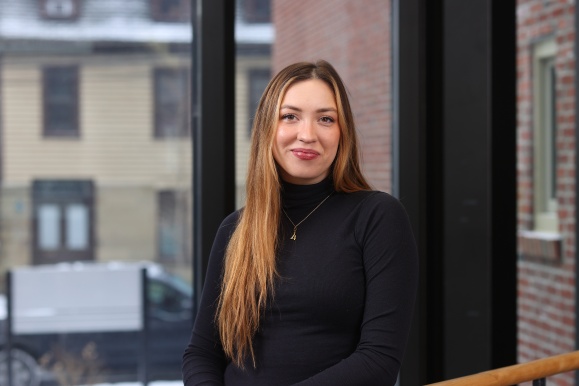News
» Go to news mainDealing with Data: Julia Sarty is equally at home in finance and health care

“Any place you go has a data team,” Julia Sarty (MASc ’23) says. As part of that team at Mosaic, a company that provides strategic finance software, Sarty spends her time “learning and listening to people from so many different industries — anything from school software, to commercial laundry, to tech security. I live and breathe their financial data and bring it into the product I work for.”
It’s not the career direction she expected when she started her undergrad as an Electrical Engineering student at Dalhousie. But, Sarty says, that speaks to the strength of Dal’s engineering programs, and in particular Industrial Engineering, which she eventually switched into. The “broad base of knowledge” she got in Industrial has served her well, she says: “I'm able to interact with customers from a variety of backgrounds, which is something you don’t get if you go to school for something very niche or don’t have that really broad background.”
Sarty, who lives in Halifax and works remotely for California-based Mosaic, did her graduate work in Industrial Engineering working with a very different set of data — four years worth of information from the emergency department at Halifax’s IWK Health Centre. Working under the supervision of Dr. Peter Vanberkel at Dal, and Dr. Majid Taghavi from Saint Mary’s University, she used machine learning to try and understand why some patients who present at hospital emergency departments leave without being seen (LWBS).
Sarty says the “bounce-back effects [of LWBS] are quite serious.” Sick patients who leave could infect others before returning. Or if they have an unaddressed issue, it could become more severe before they come back to the ED.
Since patient data is very sensitive, Sarty worked with anonymized information that would prevent individuals from being identified. Still, she says, some clear patterns emerged. One of the most striking was that people who travelled the shortest distances were more likely to leave early. “Predicting if they're going to leave or not seems to be kind of like an insurmountable task,” Sarty says.
“But we ended up building models that were able to pretty accurately predict [the possibility of LWBS] based on the administrative data we had.”
ED nurses can then use that information to predict which patients are most likely to leave and develop effective interventions.
Going from health care research to strategic finance planning may seem like a jump, for Sarty it’s a natural outgrowth of her training in Industrial Engineering at Dal. “I'm able to talk to a variety of people about a variety of subjects and understand their perspective,” she says.
“Having that broad base of knowledge keeps me learning from the people I work with now, and also makes me feel like I'm equipped to return to health care, if that's something I wanted to do.”
Recent News
- Why we remember: Women in Engineering Society marks December 6 with solemn, purposeful ceremony
- Dalhousie Grad Turns Scholarship Opportunity into a Career at Irving Oil
- New Indigenous student centre opens on Dal's Sexton Campus
- Incoming Schulich Leader aims to improve lives through innovation
- Door‑in‑Door‑out: Noreen Kamal brings an engineer’s eye to stroke treatment
- Why I Do It
- Dalhousie Student Leads the Way on Planning for 2026 Atlantic Engineering Competition
- Dalhousie Rocketry Team Soars to New Heights
